

Images: Bouncy Ball Skips on Water Like a Rock. US Navy Toys With Physics of Bouncy Balls. DENVER — A toy ball that skips on water far easier than the best skipping stone is the inspiration for a line of research that's caught the attention of the U.S.
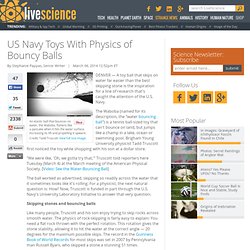
Navy. The Waboba (named for its description, the "water bouncing ball") is a tennis ball-sized toy that can't bounce on land, but jumps like a champ in a lake, ocean or swimming pool. Brigham Young University physicist Tadd Truscott first noticed the toy while shopping with his son at a dollar store.
"We were like, 'Oh, we gotta try that,'" Truscott told reporters here Tuesday (March 4) at the March meeting of the American Physical Society. [Video: See the Water-Bouncing Ball] The ball worked as advertised, skipping so readily across the water that it sometimes looks like it's rolling. Skipping stones and bouncing balls Like many people, Truscott and his son enjoy trying to skip rocks across smooth water. Most people can skip a rock just a couple times, Truscott said, and a few can achieve 10 or so.
Military toys. How to Make Magnetic Slime. Exploring Magnetism. Acknowledgements Doctors Bryan Méndez, Laura Peticolas, Nahide Craig, Janet Luhmann, and Michelle Larson developed and produced these lessons using funding from the Education and Public Outreach program of the NASA STEREO-IMPACT Mission while at the Center for Science Education at the Space Sciences Laboratory (CSE@SSL) at the University of California in Berkeley.
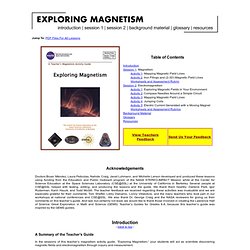
Several people at CSE@SSL helped with testing, editing, and producing the lessons and the guide. We thank them heartily: Darlene Park, Igor Ruderman, Karin Hauck, and Todd McGill. The teacher feedback we received regarding these activities was invaluable and we are especially grateful for their comments: Tom Shefler, Libby Dalcamo, Lonny Villalobos, and the many teachers who took part in our workshops at national conferences and CSE@SSL.
We also thank Dr. Introduction - back to top - An Investigation of Magnets: Complete Lesson. Magnetism. Magnetism Magnets are very common items in the workplace and household.
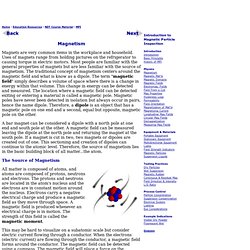
Uses of magnets range from holding pictures on the refrigerator to causing torque in electric motors. Introduction to Magnetism - Resources. Physics and Magnetism for Kids. Earth's Magnetic Field - How Compasses Work. Experiment with Magnet Magic. Is your child struggling to get a handle on the principles of magnetism?
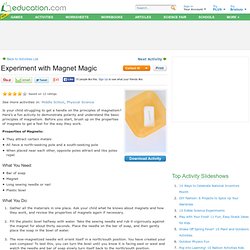
Here's a fun activity to demonstrate polarity and understand the basic principles of magnetism. Before you start, brush up on the properties of magnets to get a feel for the way they work. Properties of Magnets: They attract certain metals All have a north-seeking pole and a south-seeking pole When placed near each other, opposite poles attract and like poles repel What You Need: Bar of soap Magnet Long sewing needle or nail Plastic bowl What You Do: Gather all the materials in one place. Start seeing magnetic fields. Magnetic fields are everywhere– you just can’t see them*.

Here we introduce some basic and inexpensive visual tools, as varied as iron filings and Arduino, pre-school toys and OpenGL, for getting to know your local fields. It’s not exhaustive, but might provide you with some useful starting points for your own exploration. (*Unless you count the magnetic field inside those photonsthat you use to see things.) One of the simplest and oldest magnetic field sensors is the humble directional compass. National High Magnetic Field Laboratory - Drawing Field Lines Activity. A Portrait of Magnetism: Drawing Field Lines Magnets have two poles; the field lines spread out from the north pole and circle back around to the south pole.
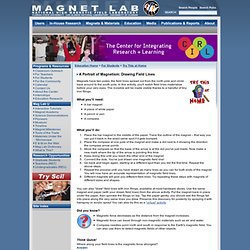
In this activity, you'll watch field lines materialize before your very eyes. The invisible will be made visible thanks to a handful of tiny iron filings. A bar magnetA piece of white paperA pencil or penA compassPlace the bar magnet in the middle of the paper. Trace the outline of the magnet – that way you can put it back in the exact same spot if it gets bumped.Place the compass at one pole of the magnet and make a dot next to it showing the direction the compass arrow points.Move the compass so that the base of the arrow is at the dot you've just made.
Science Experiments. Motion and Forces. Electricity & Magnetism: Magnetic Fields. Magnetic fields are different from electric fields.
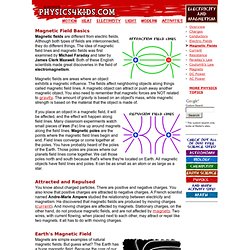
Although both types of fields are interconnected, they do different things. The idea of magnetic field lines and magnetic fields was first examined by Michael Faraday and later by James Clerk Maxwell. Exploring Magnetic Fields. Purpose To reinforce the concept that magnets attract and repel items and exert a magnetic field that can vary in strength.
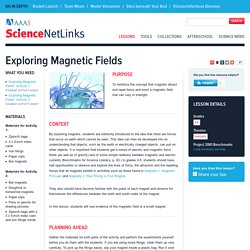
Context By exploring magnets, students are indirectly introduced to the idea that there are forces that occur on earth which cannot be seen. 15_magfields. Silly Putty in the Classroom - Reading and Science. Schools Science Clips - Forces in action. Force_motion_lab. DD354. Middle School.